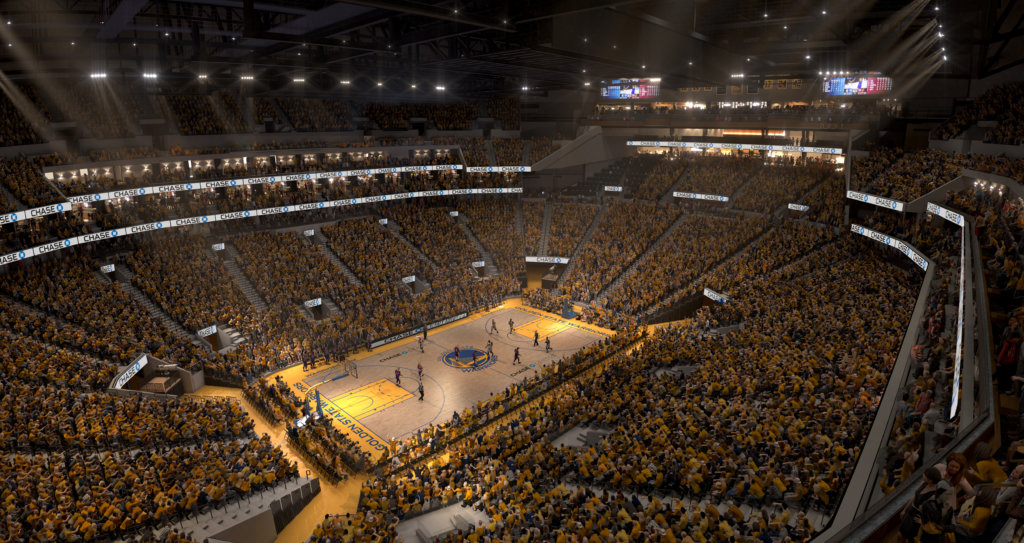 Recently, we announced an exciting partnership with the Golden State Warriors that will enable us to bring the latest in connected experiences to the Chase Center and its surrounding multi-acre campus.
Recently, we announced an exciting partnership with the Golden State Warriors that will enable us to bring the latest in connected experiences to the Chase Center and its surrounding multi-acre campus.
Starting in the fall of 2019, those attending Chase Center NBA basketball games, concerts, shows and conventions will benefit from in-venue, location-aware experiences delivered via custom mobile content and services, all powered by our Wi-Fi infrastructure.
Given our partnership with the Warriors and other sports teams, now is an excellent opportunity to give you a sneak peak at what we envision for intelligent large public venues of the future.
With ever-more sophisticated in-home options capturing our attention, LPVs will motivate us to leave our living rooms by providing incomparable on-site experiences. To do so, we expect a sophisticated and compelling convergence of physical presence with virtual technologies, including AR/VR, AI, esports leagues and live action.
Dream team immersion
As entertainment is inherently visual, let’s visualize basketball’s future from a fan’s perspective using a hypothetical game-day scenario.
It starts as our fan walks up to the venue. Tedious security checks and even e-ticketing have given way to technologies that recognize each person and automatically scan them for prohibited items, diverting only those few that fail the automated screening.
As our fan walks unencumbered into the venue, screeners are replaced by a hologram of her favorite player, who falls in beside the fan. During the ensuing interaction between our fan and the virtual athlete, they discuss game day strategies, statistics, the opponent and any other related subject.
The hologram would also be certain to make merchandise and refreshment suggestions as if they were physically walking along with our fan.
Once in her seat, our fan elects to participate in an immersive game simulation as if she were on the court. She can choose to be herself, for purposes of the other players calling her name, or assume the persona of her favorite player. Regardless, the encounter will include all of the sights and sounds a physical player experiences.
Or, our fan could join a virtual pre-game locker room simulation to participate in the strategy sessions and interact informally with other team members. At game time, she could “walk” with the team as it enters the arena and begins warm-ups.
After the game gets underway similar experiences could continue, such as ongoing conversations with holographic players about the action on the floor or visiting with holographic members of the coaching staff.
At the half, our fan could stage a scrimmage between members of her esports league and virtualized members of her physical team.
Finally, after the game, our fan could return to the simulated locker room to share in the joy of victory or gain solace for the defeat. Or, she could be entertained with immersive, participatory instant replays while she waits for physical players to emerge and sign autographs.
On the way out of the venue, our fan’s virtual player could discuss the next game while also noting options for post-game dining or entertainment that are available at the site.
So what’s it mean for IT?
While our scenario uses a sporting event, you an easily imagine an VR/AR and AI-infused experience at a rock concert, giving fans interactive and participatory simulation experiences with individual entertainers or placing them in dressing rooms and on stage.
No matter what type of event, simultaneously enabling such complex virtual interactions for thousands of visitors will also transform venue operations.
For IT, infrastructure and architectures will go beyond self-healing to become fundamentally self-evolving. Networks will automatically and proactively apply the appropriate services, intelligence and actions for adjusting to exceptionally dynamic and swiftly changing circumstances. This includes during individual events plus automatically re-tuning for the next event on the calendar, freeing IT to work on higher-value tasks.
What’s more, infrastructure analytics and AI will become integrated into the network, rather than separate services as they are today. This will not only provide IT staff with advanced notifications, but go deeper to automatically present precise details on where an issue resides and what it entails, should the network be unable to self-adjust.
If you prefer, a hologram can walk and talk you through a situation, improving your knowledge and skills along the way. Regardless, any resemblance to a hunting expedition: gone.
Similarly, marketing departments will be set free from tiresome mining data for determining whether an offer or campaign is working. Instead, the venue’s analytics-infused infrastructure will simply present outcomes and make improvement suggestions, along with supplying various types of drill-downs and visualizations.
Further, capabilities to embed offers will become ubiquitous. Using our game-day example, the background around holograms, including during simulations, will include virtual forms of digital signage that suggest merchandise or refreshment options. To make purchases, fans will simply “touch” an item they’d like to eat, drink, wear or own and it’ll appear at their seat - with all of the payment and delivery complexities completely in the background.
Or, for those who want to stretch their legs, a concierge - real or virtual, depending upon the type of guest - will show up seat-side to escort fans to their destinations while also carrying on an engaging conversation, if a fan so chooses.
On the venue partnership front, integrators will go beyond offering widgets to providing value-added services. This will range from assisting marketing departments with designing compelling, revenue-generating virtual interiors to helping IT departments train and customize AI technologies and analytics engines for maximizing network self-evolving properties.
Overall, we’re on the cusp of an LPV revolution as the scenarios we’ve presented suggest only the basics of what’s possible in the coming years. The full richness and depth offered by technologies such as VR/AR and AI are only limited by our imaginations.
In short, it’s time not just to dream, but to dream big.




